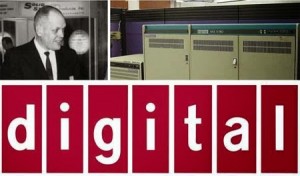 DEC was created by Ken Olsen and Harlan Anderson, two MIT engineers, in 1957 and rose to legendary status during it’s existence. The company has produced several influential computers and design concepts, forever emblazing it on the face of technology history. It is one of the first computer companies to find success in the minicomputer market with their PDP and VAX machines. From the early 60s to the 90s it was a leading manufacturer and vendor, with products like the PDP-11, PDP-8, and one of the first 32 bit minicomputers, the VAX-11. Born from the early TX-2 machine, the first DEC products shipped in 1958 and were made up of electronics and transistors mounted to a circuit board. The Digital Laboratory Module turned a record profit in 1958.
DEC was created by Ken Olsen and Harlan Anderson, two MIT engineers, in 1957 and rose to legendary status during it’s existence. The company has produced several influential computers and design concepts, forever emblazing it on the face of technology history. It is one of the first computer companies to find success in the minicomputer market with their PDP and VAX machines. From the early 60s to the 90s it was a leading manufacturer and vendor, with products like the PDP-11, PDP-8, and one of the first 32 bit minicomputers, the VAX-11. Born from the early TX-2 machine, the first DEC products shipped in 1958 and were made up of electronics and transistors mounted to a circuit board. The Digital Laboratory Module turned a record profit in 1958.
Later on the PDP-1 was developed and shown publicly for the first time in 1959. The machine was produced until 1969 and DEC sold 53 of them. The PDP-4 was released in 1962, followed by the PDP-7 in 1964, the first machine that ran Unix. Following up with the VAX architecture in 1976, they also introduced some of the early concepts of cluster machines, incorporating the VAXcluster technology into the line which became the first clustering system to achieve commercial success. In 1977 Olsen famously scoffed at microcomputers, believing there wasn’t any need for an individual to have a computer in their home.
